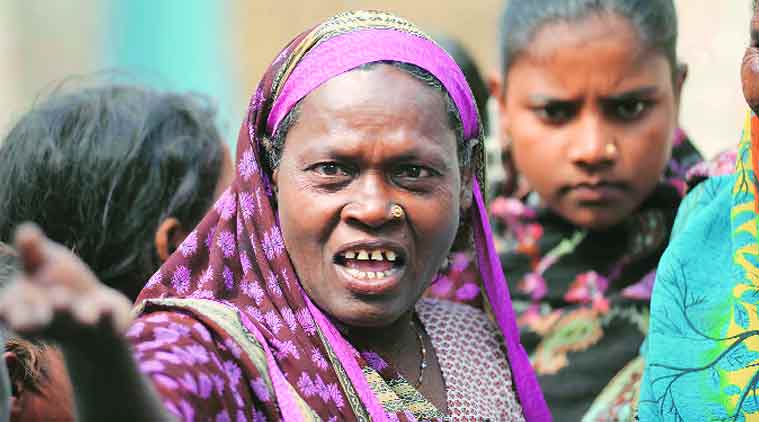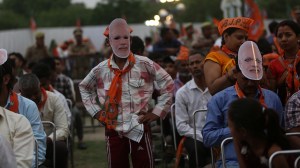- India
- International
Jitan Ram Manjhi’s exit draws new faultlines in Nitish’s backyard
Mahkar's gains have sparked some envy, even resentment, in this area of deprivation.
 At Mahadalit cluster in Kalyanbigha, Nitish’s village: ‘If every CM gets five years, why not Manjhi?‘
At Mahadalit cluster in Kalyanbigha, Nitish’s village: ‘If every CM gets five years, why not Manjhi?‘
How would you feel if someone led you to a beautifully laid out feast, and just as you were about to sit down to it, pulled it away from you?” asks Ranjit Manjhi, a Musahar and a daily wage labourer in Mahkar, the small village with a helipad that Jitan Ram Manjhi, Bihar’s Mahadalit Chief Minister for nine months, belongs to.
Electricity came to Mahkar only after Manjhi became Chief Minister. A new thana is still being built, as also a panchayat bhavan, middle school and power station. The blue and white health centre, now operational, is still festooned with dried marigold garlands that recall its inauguration in December last year.
Mahkar’s gains have sparked some envy, even resentment, in this area of deprivation, where the state is a very thin, very faltering presence.
[related-post]
This is particularly so in the Dalit settlements which can be found at the village’s end, or in its poorest and darkest corners.
Yet, despite the envy, Mahkar’s sense of betrayal and hurt at the unseating of Manjhi by Nitish Kumar, the man who installed him as CM in the first place, is echoed in Mahadalit sections of the nearby villages where they have also watched the changes in Manjhi’s village with hope and expectation.

Here, nobody has any land or job, virtually everyone is a daily wage labourer, electricity is erratic when it is there, or has gone missing ever since the transformer that served this side of the village burnt and wasn’t repaired two months or two years ago. Water must be hauled from handpumps installed by using up meagre private resources because the government pump ran dry, and unpaved lanes fill up with water and sewage.
In Navdiha, Kaushal Kishore, a teacher, and a Paswan, the last and relatively better-off Dalit caste to be added to the Mahadalit category by the Jitan Manjhi government, asks: “If your son starts doing better than you, will you cut him down? If Nitish resigned on principle, why is he coming back now? Would he have taken his CM-ship back in this manner if he had installed someone from the forward caste in his place?”
Ramprit Das of the same village agrees: “Nitish had hoped he would be able to remote control Manjhi,” he says. And in Kudwa, young Anup Kumar asks: “If he made a son of a poor man the chief minister, why is he removing him now?”
As Nitish Kumar returns as Chief Minister of Bihar, he must know that things are not as he left them when he stepped down in the immediate aftermath of the 2014 Lok Sabha polls.
For one, Jitan Ram Manjhi, the low-profile Mahadalit leader Nitish made CM and then sought to remove after a conspicuous falling out, is no longer little-known.
As the Nitish vs Manjhi drama raced towards its last scene in Patna, The Indian Express travelled to Mahadalit clusters in Gaya and Nalanda, home districts of Manjhi and Nitish respectively, to find that Manjhi’s resignation may not have brought down the curtains on this saga.
With Assembly elections eight months away, a new faultline is being drawn among Bihar’s disprivileged, and there could be a new tug of war among the state’s most deprived.
Musahars, the caste group Jitan Manjhi belongs to, are the lowest of Bihar’s 22 Dalit castes, 18 of whom were identified as “Mahadalit”, or the most deprived of the deprived, for better targeting of government schemes by a Mahadalit Commission set up by Nitish Kumar in 2007 — now, with all Dalits being included in the Mahadalit category, that distinction has been rendered meaningless.
Musahars can barely manage to avail of the benefits of even the special schemes meant for Mahadalits — scholarships and free uniforms for students require attendance targets that these children of households that struggle to survive daily are often unable to meet, and very few children are able to stay in school long enough to get the free cycle that the state promises to girls and boys in Class 9. There are hardly any homes with toilets because government compensation follows, not precedes, their construction.
Anger and resentment at Jitan Manjhi’s ouster can be heard not just among the Musahars and other Mahadalits in his home district of Gaya, but also in Nitish’s backyard.
In the Musahar cluster in Nitish’s village of Kalyanbigha, where the same absences and indignities mark the Dalit section of the village — water and electricity wanes and the women say they are sneered at by landowners when they go to relieve themselves in the surrounding fields — Surekha Devi asks: “If Manjhi can be pushed aside, removed from his job, even after he went to Delhi, met Modi, what hope do we have that our children will ever get jobs?”
Jantu Devi, who compares Manjhi’s shortlived tenure to “cumin seeds crackling in a vessel filled with hot oil”, asks: “Where did he have the time to deliver?” For Deva Devi, the question is: “If every CM gets five years, why not Manjhi?”
In the nearby village of Cheran, in the Ravidas cluster, where government laid a pipe and then turned away — there is no tap and no water connection — young Suman Kumar, a graduate with no job, feels that had he been allowed to stay longer, Jitan Manjhi would surely have done some good work. Because “only a poor man can understand the problems of the poor.”
Many, in Nalanda as well as in Gaya, still associate “development” only with the Nitish regime. He was the chief minister who first promised that the state would deliver to Bihar’s darkest corners, and even though that promise faltered by the time it reached their own corner of the village, it was Nitish who christened them “Mahadalit”, built the road and brought the “rifle raj” under Lalu to an end. Many lament the falling out between the two men on the same side that is now forcing them to choose one over the other.
At Kalyanbigha, Kari Devi feels Nitish should have somehow kept Manjhi “paachche-paachche”, by his side. “If two brothers fight, it will be the third party (BJP) who gets a chance,” says Umesh Paswan, who runs tuition classes in his jhuggi in the same village.
Though some like Umesh Paswan describe the Nitish vs Manjhi as a fight between “brothers”, mostly it is pictured in images that frame two unequals. In Gonawan village in Nalanda district, Siddheswar Manjhi asks: “If I get married, and two months later, I turn out my wife, will it be fair?” Jitan Manjhi, many say, had to finally resign ahead of the Assembly test of strength to save his self-respect.
As the elections approach, the cracks may be widening at the bottom of the alliance of the backwards that Nitish hopes will replace the “coalition of extremes” that he put together in partnership with the BJP, and which became endangered after the BJP carried away a large section of the upper castes after the split with the JD(U).
Much will depend on how Nitish and Manjhi play it from here — on whether or not Manjhi can strike out on his own, and whether or not Nitish can use his remaining term to address and woo back the Mahadalits he has alienated because of his rift with Manjhi or because of the state’s incapacity to deliver.
Both men also know that for the Mahadalit, eight months is a very long time. As Siddheswar Manjhi of Gonawan village says, “What I cook today in my home depends on the wage I get from the work I may or may not find today. If I don’t know what I will cook in my home tomorrow, how can I tell you whom I will vote for eight months later?”
Apr 25: Latest News
- 01
- 02
- 03
- 04
- 05







































